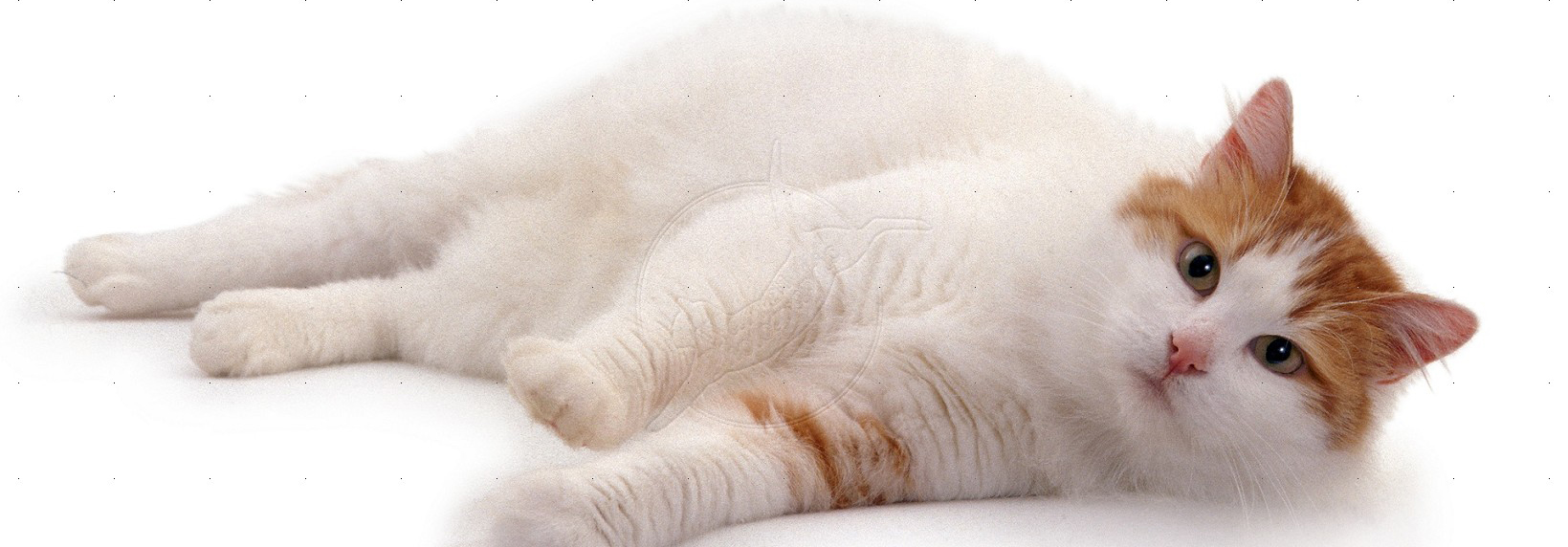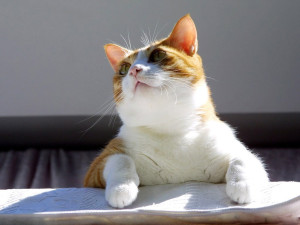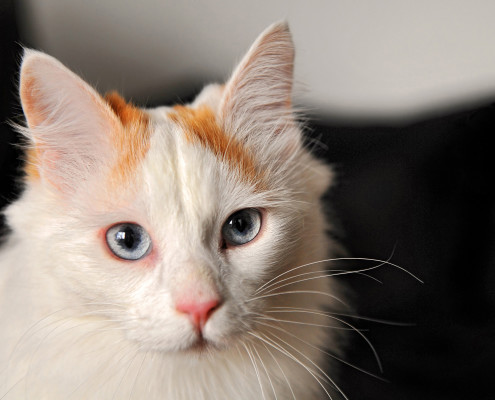Turkish Van

Meoww!!
The Turkish Van is a large cat with a graceful yet muscular body, unusually broad chest and shoulders. The breed is naturally well-balanced and well-proportioned.
In 5 Words
- Very smart
- Friendly
- Affectionate
- Devoted
- Loving
Snapshot
Size: Large
Weight: 12-14 lbs
Origin: Turkey
Life Span: 10-14 years
Colour: White

Characteristics
Learn About the Turkish Van
When the Ark arrived at Mount Ararat some 5,000 years ago, Noah must have been a bit busy keeping the animals from stampeding in their eagerness to touch dry land. In the hustle and bustle, two white and red cats leaped into the water and swam ashore. When the flood receded, the cats set out for Lake Van, located about 75 miles (121 km) to the south of Mount Ararat, where they have lived ever since. Archaeological evidence hints that domestic cats were known in Turkey as long as 7000 years ago. Excavations by the British Archaeological Institute uncovered small Neolithic figures of women holding, or playing with cats.
These terracotta statuettes are thought to be the oldest known representations of pet cats. From AD75 to AD387 the Romans occupied the Lake Van region in Eastern Turkey. Battle armor from this period displayed in the Louvre Paris, shows large light colored cats with tail rings, these are believed to prove an early presence for the Turkish Van Cat. It was only discovered in the mid-1950’s when Laura Lushington and Sonia Halliday were on tour in Turkey. On their travels they came across white cats with auburn markings on their heads and tails.Two unrelated kittens were given to them and these kittens continued travelling with them.
In 1955 a journalist working for the Turkish Tourist Board, Laura Lushington, and her friend, Sonia Halliday, a photographer, were offered two Turkish Van kittens (a male and a female), and successfully brought them back into Britain, in the 1970s, but it was not until breeders Barbara and Jack Reark started working with the breed in 1983 that the Vans began to flourish in the United States. although The International Cat Association recognized them in 1979. They are also recognized by the Cat Fanciers Association and other cat registries. In 1985 TICA granted the Turkish Van Championship status. The CFA accepted the breed for registration in 1988, and in May 1993 the Van achieved Provisional status with the CFA. Today, the Turkish Van is accepted for championship status by the Cat Fanciers Association and The International Cat Association.
The Turkish Van is a large cat with a graceful yet muscular body, unusually broad chest and shoulders. The breed is naturally well-balanced and well-proportioned. The strong legs are medium length with neat round paws. The hind legs are slightly longer. The neck is relatively short. The wedge-shaped head is relatively wide with large ears set high. The nose is medium to long with a slight stop in profile. The oval eyes are large and expressive; their colour can be amber, blue, or odd-eyed.
The coat is soft and silky, with no woolly undercoat, although the winter coat is denser than the summer coat, and it has a full ruff, which becomes more pronounced with age. The tail is a magnificent full brush, and there are dramatic tufted ears. This breed is defined by its name as having the “van” coat pattern, in which the body is covered with chalky white fur and all colour markings are confined to the head and tail. Eyes are amber or blue with pink pigmentation on the rims. Male Vans weigh about 16 pounds, females weigh 12 to 14 pounds.
Turkish Vans are very smart, friendly, affectionate and devoted, which makes them wonderful companions. Whatever you do and wherever you go, they always want to be near. Amazingly energetic and agile, Vans are known to be great climbers, loving, loyal, curious, companionable and affectionate. They like to play, jump and explore anything that is within their reach or range of vision.
Many Vans are dedicated to fetching their particular object of interest, and many Turkish Van owners describe them as being “dogs in a cat suit” because of their charming personalities.Turkish vans are famous for their affinity with water, games involving bowls of water with toys or ice is recommended if safely supervised. Turkish Vans are known to be great swimmers. . The voice of the Turkish Van is also quite unique, described by many owners as sounding rather like a sheep, albeit a quiet one.But when they are hungry, they go to the kitchen door and meows to indicate that they are hungry.
Congenital deafness may be present in Turkish Van’s with a white coat and blue or odd-colour ed eye,Feline Infectious Peritonitis, Giardia, Feline Leukemia Virus, Rabies, Feline Parvovirus, Herpesvirus (Rhinotracheitis),Calicivirus
Turkish Van will need regular combing to keep it free from knots and tangles, and to remove any loose hairs which could cause fur balls. Increased brushing when the coat is shedding will reduce white hair on clothes and furniture. Although their affinity with water, it is best to start bath the Van’s coat at an early age.
They will eat most good quality brands of cat food, and will enjoy treats of chicken, ham and even grated cheese. However, cows’ milk will probably give them a stomach upset, and a bowl of water should always be available. With their interest in water it is especially important with this breed of cat that toilet seats are kept firmly down.






